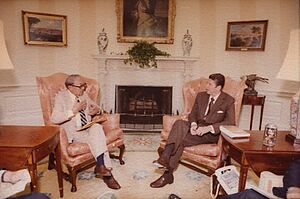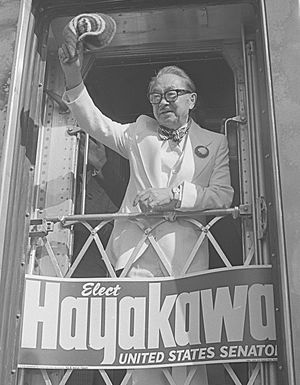S. I. Hayakawa facts for kids
Quick facts for kids
S. I. Hayakawa
|
|
|---|---|

Hayakawa in 1981
|
|
| United States Senator from California |
|
| In office January 2, 1977 – January 3, 1983 |
|
| Preceded by | John V. Tunney |
| Succeeded by | Pete Wilson |
| 9th President of San Francisco State University | |
| In office November 26, 1968 – July 10, 1973 |
|
| Preceded by | Robert Smith |
| Succeeded by | Paul Romberg |
| Personal details | |
| Born |
Samuel Ichiye Hayakawa
July 18, 1906 Vancouver, British Columbia, Canada |
| Died | February 27, 1992 (aged 85) Greenbrae, California, U.S. |
| Political party | Republican (from 1973) |
| Other political affiliations |
Democratic (before 1973) |
| Spouse | Margedant Peters |
| Children | 3 |
| Education | University of Manitoba (BA) McGill University (MA) University of Wisconsin, Madison (PhD) |
|
Notable work
|
Language in Thought and Action |
| Scientific career | |
| Institutions | University of Wisconsin, Madison Armour Institute of Technology University of Chicago San Francisco State College |
| Thesis | Oliver Wendell Holmes: Physician, poet, essayist (1935) |
| Influences | Alfred Korzybski |
Samuel Ichiye Hayakawa (born July 18, 1906 – died February 27, 1992) was an important person in both education and politics. He was born in Canada but became an American citizen. He was a professor of English, meaning he taught about the English language and literature. Later, he became the president of San Francisco State University. After that, he served as a U.S. Senator for California from 1977 to 1983.
Contents
Early Life and School
Samuel Ichiye Hayakawa was born in Vancouver, British Columbia, Canada. He went to public schools in Calgary, Alberta, and Winnipeg, Manitoba. He finished his first degree at the University of Manitoba in 1927.
He then earned a master's degree in English from McGill University in 1928. In 1935, he received his PhD, which is a very high degree, from the University of Wisconsin–Madison.
Academic Career and Books
Hayakawa was a smart person who studied many things. He was a linguist, which means he studied language. He was also a semanticist, someone who studies the meaning of words and how they affect our thoughts. He worked as a teacher and writer.
From 1936 to 1939, he taught at the University of Wisconsin. Then, from 1939 to 1948, he taught at the Armour Institute of Technology, which is now the Illinois Institute of Technology.
His most famous book was Language in Thought and Action. This book helped many people understand general semantics. General semantics is a field that looks at how language shapes our thinking and behavior. The book showed how important it is to use language clearly and carefully.
Hayakawa also taught at the University of Chicago from 1950 to 1955. He wrote articles and gave talks about how language and meaning affect our lives.
Leading San Francisco State College
From 1955 to 1968, Hayakawa was an English professor at San Francisco State College. In the 1960s, he helped start a group that was against changing telephone numbers to all digits.
He became the acting president of San Francisco State College on November 26, 1968. This happened during a big student strike. On July 9, 1969, he was officially named the ninth president of the college. He retired from this role on July 10, 1973.
After retiring, Hayakawa wrote a newspaper column from 1970 to 1976. In 1973, he changed his political party from the Democratic Party to the Republican Party.
Student Strike at San Francisco State
From November 1968 to March 1969, students at San Francisco State College went on strike. They wanted to create a program for ethnic studies, which would teach about the history and cultures of different ethnic groups. This strike was a very big event at the time.
The students made several demands. One demand was to create a Black Studies department. Another was to allow all Black students to attend the university. They also wanted the university to stop its involvement in the Vietnam War. The students said they would shut down the campus if their demands were not met.
During this time, Hayakawa became well-known to conservative voters. He famously pulled the wires from a loudspeaker on a protest van during a rally. On December 6, 1968, he agreed to create a Black Studies program at the university.
Political Career
In 1976, Hayakawa won a surprising victory in the Republican primary election for the U.S. Senate. He was seen as a political outsider, which means he was not a typical politician. This idea was popular after the Watergate scandal.
He then ran against the current Democratic Senator, John V. Tunney. Tunney was expected to win easily. However, Hayakawa pointed out that Tunney often missed votes in the Senate. Hayakawa used a TV ad showing an empty chair in the Senate to make his point. Hayakawa slowly gained support and ended up winning the election by a small amount.

As a Senator, Hayakawa supported the Torrijos–Carter Treaties. These treaties transferred control of the Panama Canal from the United States to Panama. He also supported a bill that created a commission to study the imprisonment of Japanese Americans during World War II. During his time in the Senate, he was one of three Japanese Americans serving in that chamber.
Hayakawa decided not to run for re-election in 1982. He was replaced by Pete Wilson. To this day, he is the only Japanese American Republican to have served in the U.S. Senate.
Hayakawa also helped start an organization called U.S. English. This group works to make English the official language of the United States. Even though he supported studying the internment of Japanese Americans, Hayakawa believed that the internment was helpful. He argued that Japanese Americans should not be paid for it.
Personal Life
Samuel Hayakawa lived in Mill Valley, California. He passed away in nearby Greenbrae in 1992. He loved traditional jazz music and wrote a lot about it. Sometimes, during his lectures, a jazz pianist named Don Ewell would join him to help explain ideas about language and music.
Hayakawa was known for sometimes napping during important votes in the Senate, which reporters often noticed. His daughter, Wynne Hayakawa, is a painter.
See also
 In Spanish: S. I. Hayakawa para niños
In Spanish: S. I. Hayakawa para niños
- List of Asian Americans and Pacific Islands Americans in the United States Congress
- List of United States senators born outside the United States


